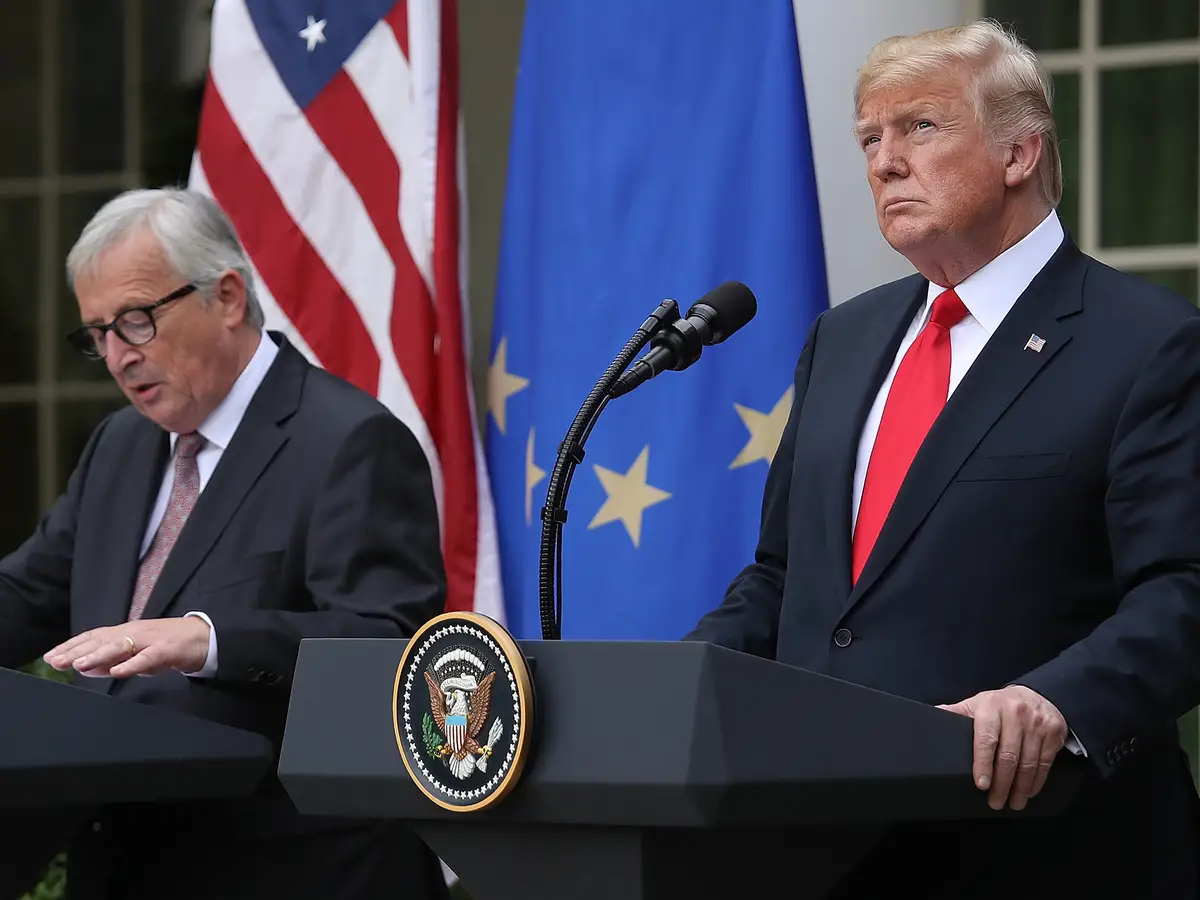America’s Trade Shakeup: How the New U.S.–EU Deal Could Slash Imports and Redraw Global Supply Chains
America’s Trade Shakeup: How the New U.S.–EU Deal Could Slash Imports and Redraw Global Supply Chains
By
Calder Monroe
Last updated:
July 28, 2025
First Published:
August 6, 2025

Photo: Business Insider
U.S.–EU Tariff Deal Could Slash Imports by $2.68 Trillion by 2027
A dramatic shift is looming for American trade as the United States enacts a new tariff regime under a landmark trade deal with the European Union. Announced by former President Donald Trump following high-level negotiations with European Commission President Ursula von der Leyen, the deal introduces a sweeping 15% tariff on most EU exports to the U.S.—including automobiles, machinery, and luxury goods.
This aggressive move, analysts warn, could cause seismic disruptions in global trade flows. According to a comprehensive projection by the Observatory of Economic Complexity (OEC)’s Tariff Simulator, total U.S. imports could plummet by 46% by 2027, equating to a $2.68 trillion decline, compared to the average levels seen between 2024 and 2026.
U.S. Exports Set to Rise—but at What Cost?
While imports are projected to drop sharply, the OEC model forecasts a 12% rise in U.S. exports globally, reaching $1.59 trillion by 2027. This is driven by restructured trade routes, particularly with countries not retaliating with reciprocal tariffs.
But experts caution that these export gains might not fully compensate for the broader losses in trade efficiency and consumer diversity. Much of the world is expected to rewire their import strategies—away from the U.S.—in an effort to avoid the ripple effects of the new tariffs.
Countries Pivot Away from U.S. Trade
“The rest of the world isn’t imposing tariffs on each other—just the U.S.,” says César Hidalgo, Director of the Center for Collective Learning and the creator of the OEC Tariff Simulator. “As a result, global trade routes are shifting away from American ports.”
Hidalgo points out that deeply integrated nations like Mexico and Canada may struggle to reroute trade as easily as other countries. But for Europe and Asia, this new framework could accelerate partnerships elsewhere.
For instance, Germany, under a no-tariff scenario, was projected to boost exports to the U.S. from $133 billion in 2023 to $155 billion in 2027. But with the new 15% tariff, that growth is stunted, reaching only $149 billion by 2027—a clear loss compared to earlier expectations.
U.S. Import Forecasts by Country: Who Gains, Who Loses
The reshaped import landscape is evident in the OEC's projections:
- Increased Imports:
- United Kingdom: +$22.5 billion
- France: +$10.2 billion
- Spain: +$5.65 billion
- Decreased Imports:
- China: -$485 billion
- Canada: -$300 billion
- Mexico: -$238 billion
China, once the U.S.'s largest supplier, is anticipated to redirect its exports toward nations like Russia (+$70 billion), Vietnam (+$34.4 billion), and Saudi Arabia (+$28 billion).
Meanwhile, Chinese imports from the U.S. are expected to contract by $101 billion, potentially deepening the trade imbalance and intensifying geopolitical frictions.
Corporate Giants Brace for Tariff Turbulence
The impact on companies will be significant—especially those heavily reliant on EU supply chains. U.S. customs and shipping data from the OEC reveals the most exposed firms:
- IKEA: 28% of its U.S. imports come from the EU
- Southern Glazer’s Wine and Spirits: 9%
- Continental Tire: 4%
- Bosch: 4%
- Dole Food Company: 3%
- Diageo: 2.3%
Many of these companies import high-value goods, which are now vulnerable to steep tariff penalties. Industry experts say shipments of equipment such as construction machinery, transformers, and even agricultural devices are already being delayed or canceled.
Andrew Abbott, CEO of Atlantic Container Line, warns that companies are pausing orders until clearer tariff structures are established. “A $300,000 piece of machinery could now carry an added $90,000 in tariffs. That’s not a small hit,” he said.
Product Categories Hit Hardest
Certain industries are particularly vulnerable. Based on EU-to-U.S. export breakdowns:
- Furniture: 11% of top EU exports
- Rubber Tires: 7%
- Bedspreads: 6%
- Wine and Spirits: 5%
For American retailers and consumers, this could result in a noticeable decline in product variety and potentially higher prices—especially for household goods, European luxury items, and food products.
Broader Economic Risks and Uncertainties
While the tariff policy is designed to protect American manufacturing and incentivize local sourcing, the broader implications could be counterproductive. Layered tariffs often create confusion across supply chains, discourage international partnerships, and inflate costs across the board.
The U.S. Chamber of Commerce, in a recent memo, noted that long-term tariffs without global alignment “can undermine investor confidence, inflate operational costs, and diminish U.S. competitiveness.”
Final Thoughts
The 15% tariff on EU goods may seem like a protective measure on paper, but in practice, it could cost the U.S. trillions in lost imports, choke off product diversity, and rewire global trade away from American ports. As businesses and governments react to the shockwaves, the key question remains: Is the short-term gain in export value worth the long-term realignment of global trade?
Whether you're a consumer, investor, or policymaker, the aftershocks of this trade deal will be felt for years to come.
Popular articles
Subscribe to unlock premium content
Disney’s Timeless Magic and How the Entertainment Giant Continues to Shape Culture and Innovation

Imran Khan’s Economic Missteps Amid Political Chaos in Pakistan

The Philippines’ Digital Shift How Remittances and BPO Are Fueling Growth

Disney’s Timeless Magic and How the Entertainment Giant Continues to Shape Culture and Innovation

Imran Khan’s Economic Missteps Amid Political Chaos in Pakistan

Disney’s Timeless Magic and How the Entertainment Giant Continues to Shape Culture and Innovation









